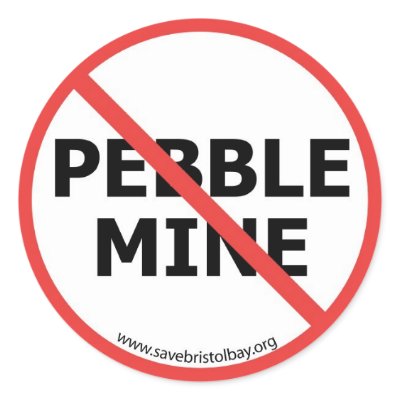Sen. Cantwell takes on Pebble Mine
Our very own U.S. Senator Maria Cantwell said that she would oppose development of the world’s largest hard rock mine, the Pebble Mine, in Alaska’s Bristol Bay watershed should science determine it could negatively impact the salmon populations on which thousands of Washington commercial fishery, seafood processing, culinary, recreational fishing, and ecotourism jobs depend.
Cantwell is the first U.S. Senator to call on the Environmental Protection Agency to block any large development project in Bristol Bay – like the Pebble Mine proposal – if the EPA finds that this development would harm salmon and the livelihoods that depend on salmon.
In a letter sent to EPA Administrator Lisa Jackson, Cantwell expressed her support of the EPA’s decision to conduct a thorough scientific analysis of the effect a large-scale development project would have on the Bristol Bay watershed, adding that the Bristol Bay salmon populations are “economic lynchpins” for commercial fishermen not just in Alaska but also in Washington state. Bristol Bay is one of the most productive salmon runs in the world, generating a total value of at least $500 million dollars each year for commercial and recreational fisheries.
Thousands of Washington state jobs, including processing and the restaurant industry, depend on healthy, sustainable salmon populations. In 2008, Bristol Bay yielded over $113 million dollars in total value for Washington state commercial fisheries while recreational salmon fisheries yielded an additional $75 million for Washington state businesses alone.
The Pebble Mine is currently under consideration for proposal by British-based Anglo-American, PLC, and Canadian-based Northern Dynasty Minerals, Ltd. According to the companies’ review of the proposed mine site, fully mining the copper, gold, molybdenum, and other metals would produce over seven billion tons of waste rock, a toxic stew that would be deposited in massive new artificial lakes. Seepage into the groundwater could adversely impact the Bristol Bay watershed, which is the main outflow for the rivers and streams in the proposed mine area. Contaminated water and industrial mining activities would threaten the pristine local environment and the diverse marine and terrestrial life that depend on it, in particular the wild and healthy salmon populations that thrive in the watershed.
Here is the full text of her letter sent on Monday:
September 12, 2011
Lisa Jackson, AdministratorEnvironmental Protection AgencyAriel Rios Building 1200 Pennsylvania Avenue, NW Washington, DC 20460 Dear Administrator Jackson, I write in support of the Environmental Protection Agency’s (EPA) decision to conduct a scientific analysis of the effect a large-scale development project could have on the Bristol Bay watershed. A science driven, independent process is critical to evaluating the potential risks a new large-scale hard rock mine, such as the proposed Pebble Mine, could have on water quality in this pristine world-class salmonid habitat. The potentially devastating impacts – both economic and environmental – of mining activities or fill material and mining waste reaching waters that support valuable salmon fisheries must be thoroughly examined and evaluated through the most rigid scientific standards.
Wild salmon populations around the world are disappearing at an alarming rate. Bristol Bay, one of the only remaining undeveloped salmon habitats, supports the world’s largest sockeye salmon fisheries, one of the largest king salmon runs, and abundant trophy rainbow trout.
EPA’s assessment should focus on a transparent, science-based process which relies on a broad range of experts and peer-reviewed research. To aid this effort, I strongly recommend the EPA collaborate and leverage the expertise of other key federal agencies. In particular, I recommend that the Agency utilize the National Marine Fisheries Service (NMFS) and the United States Geological Survey (USGS) who have unique Bristol Bay regional data. NMFS scientists at the Alaska Fisheries Science Center in Seattle regularly conduct stock assessment surveys in the Bristol Bay ecosystem which can provide essential baseline data required for EPA’s study. In addition, the work of experts at the USGS will be invaluable to the EPA in characterizing the long-term risk tectonic activity could have on the integrity of any toxic tailing pools.
In addition to the many scientific questions which will be addressed by EPA’s analysis, I also ask you to please keep in mind that the salmonid populations in Bristol Bay are economic lynchpins for commercial fishermen, not just of Alaska but also of my home state of Washington. Thousands of my constituents have contacted me expressing their concerns regarding the potentially catastrophic and widespread long-term impacts of the proposed Pebble Mine, which would be the world’s largest man-made excavation. Nearly a thousand Washingtonians hold commercial fishing permits in Bristol Bay, supporting thousands more fishery jobs in my state. In 2008, Bristol Bay commercial fisheries – including a catch of around 42 million sockeye – yielded over $113 million dollars while recreational salmon fisheries yielded an additional $75 million for Washington State businesses alone. In total, the Bristol Bay commercial and recreational salmon fisheries are worth at least half a billion dollars annually.
Due to the importance of this issue to Washington State and the Pacific Northwest, I would greatly appreciate being informed about all developments on this matter. Should scientists determine that pollution from a large-scale development in the Bristol Bay watershed could have unacceptable adverse impacts on water quality and the fish stocks that depend on it, I would support efforts to prohibit or appropriately restrict such activities, including the utilization of Section 404(c) of the Clean Water Act.
Sincerely, Maria CantwellUnited States Senator
cc: Dennis McLerran, EPA Region 10 Administrator
